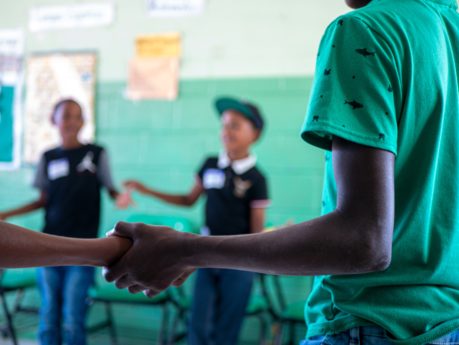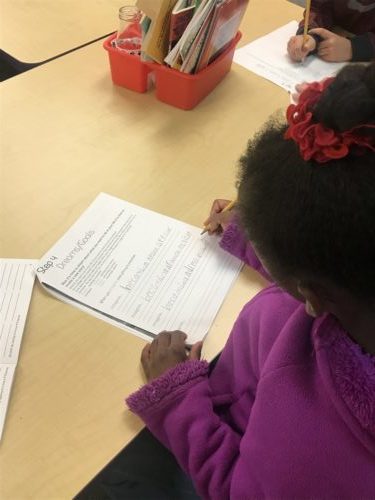 Stress is everywhere. You can almost feel it in the air. Our community, our state, our country, and the world are facing a difficult time—a global Coronavirus pandemic. Who would have thought a year ago we would be here, living in the new normal—unable to leave our homes, no school, no sports, and no playtime with friends (for kids and adults). With this new (temporary) normal we can find ourselves feeling a gamut of emotions—fear, stress, overwhelm, anger, terror, confusion, relief, even joy—we can feel all of these in a matter of minutes! If we are feeling these emotions, our kids are too.
Stress is everywhere. You can almost feel it in the air. Our community, our state, our country, and the world are facing a difficult time—a global Coronavirus pandemic. Who would have thought a year ago we would be here, living in the new normal—unable to leave our homes, no school, no sports, and no playtime with friends (for kids and adults). With this new (temporary) normal we can find ourselves feeling a gamut of emotions—fear, stress, overwhelm, anger, terror, confusion, relief, even joy—we can feel all of these in a matter of minutes! If we are feeling these emotions, our kids are too.
It’s important to give your kids tools to build their resilience. Tools to support their inner resilience so they know they will be okay—an important lesson of life really—tools kids and adults can use forever. When we are stressed, particular overly stressed, we can’t just hope it will go away, or someone will fix it for us. We must dig down deep—pull up the bootstraps as they say—and find the strength to cope, move forward, and thrive. How can we help ourselves, and our kids stay positive, and build a strong sense of self in these challenging times? Here are a few suggestions.
- Expressing how we feel: Coping with stress begins with emotional expression. Conversations with our children asking questions that begin with the words, “How…” or “What…” for example, “How are you feeling about hearing that from your friends?” “What are you feeling about that idea?” This begins the conversation so you can explore both your own feelings, and your child’s. Another wonderful tool to help children (and adults) express emotion is The Imagine Project writing tool. The Imagine Project writing tool is a 7-step writing process that asks specific questions so the writer can express their feelings (using the word “Imagine”) and even Imagine new possibilities of how their personal story might end. It’s a simple, yet powerful tool that is FREE to download from theimagineproject.org.
- Releasing negative emotion: Many believe (including myself) that we hold onto negative emotion in our bodies as energy. When we hold on to this negative energy it can create immediate or long-term health problems such as aches and pains or worse—major issues like high blood pressure or cancer. One of the ways we can release the pent up negative energy is through exercise and movement. So move! Dance, jump, play, exercise, play hide-n-seek—whatever gets you and your children moving! It’s best if you move for 20 minutes or more and get your heart rate up, but do what you can. Another amazing tool is called Emotional Freedom Technique or Tapping. Tapping is a form of energy releasing by using your fingers to gently tap on acupuncture points on the body while making simple statements. You can watch videos on this website to learn more about tapping or you can go to another website/app that is very helpful in learning how to tap, especially with kids, thetappingsolution.com. I highly recommend you check it out!
- Mindfulness: Mindfulness is powerful in calming our nervous systems. Stress speeds up our nervous systems. Being “sped up” all the time is not good for our health—it releases hormones that can negatively impact our body—creating illness. It’s particularly bad for kids to be stressed and sped up constantly as their neuropathways are developing and will stay in fast mode for life, creating anxiety and other issues. So we need to slow our nervous systems down—actively making our minds and bodies take it easy and relax. Mindfulness is a good way to slow our minds and bodies down—and it’s easier than you think. Sitting and doing a puzzle, cooking, humming (humming is very good for your nervous system), going for walks, or reading together are all mindfulness techniques. Think of the relaxing things you like to do with your kids—and make it a habit to do them everyday, more than once a day. With the stress so intense right now, it’s extremely important to actively practice mindfulness as much as possible. If you want to learn more, you can Google mindfulness or go on YouTube to listen to mindfulness meditations. If you have elementary school age children go to gonoodle.com for great quick mindfulness videos that kids love (it’s free).
These are important times to find extra support for ourselves and our children—the stress around us is intense. Set your intentions around what positive things you want to get from this period of time, ask your kids to set some intentions too. Learning to relax, spending more time together, connecting with old friends, the world coming together again, are a few that come to mind. There is always good that comes from life’s challenges.
We can all make it through this—and be even better on the other side. Try some of these suggestions today. Download The Imagine Project journals and write your imagines together as a family. If you are a teacher have your students to it—it will be amazing! Teach your children they can be resilient and overcome any challenge—it may take a little extra work, but of course it’s important for them to learn that too.
Good luck and stay well,
Dianne Maroney, RN, MSN
The Imagine Project, Inc., is a nonprofit organization that helps kids, teens, and adults overcome challenging life circumstances through expressive writing. Dianne is a thought leader in the area of stress and trauma in children. Her simple, yet profound 7-step writing tool, now used by schools across the US and internationally, gives kids and teens the opportunity to rewrite a challenging personal story and Imagine new possibilities in its place.

 Numerous studies have been conducted that reveal just how much stress today’s kids are under. Sadly, we see it every day revealed in bullying, anxiety, depression, chemical abuse, and even suicide. Youth are suffering with stress and trauma, and those labeled as “at risk”, such as foster kids, have more to overcome than the average student. One of the ways we are able to support them is through
Numerous studies have been conducted that reveal just how much stress today’s kids are under. Sadly, we see it every day revealed in bullying, anxiety, depression, chemical abuse, and even suicide. Youth are suffering with stress and trauma, and those labeled as “at risk”, such as foster kids, have more to overcome than the average student. One of the ways we are able to support them is through  Every parent wants the best for their children. We work hard at making sure they eat right, do well in school, get enough sleep, etc. Another area that needs a great deal of focus is their emotional wellness. Emotional wellness means a child is able to express emotion, feel empathy and compassion, have health relationships, communicate freely, be responsible, accept help, have fun and feel joy, and be able to bounce back when they face adversity. Emotional wellness is key to being resilient in the face of any adversity. And since adversity is an integral part of life, we can’t really shield our children from it. Instead, we can promote emotional wellness and resilience by giving them tools to cope—lasting tools that can equip them to weather all the storms they encounter throughout their lives. Here are seven tips to help you help you help your child be their best self emotionally.
Every parent wants the best for their children. We work hard at making sure they eat right, do well in school, get enough sleep, etc. Another area that needs a great deal of focus is their emotional wellness. Emotional wellness means a child is able to express emotion, feel empathy and compassion, have health relationships, communicate freely, be responsible, accept help, have fun and feel joy, and be able to bounce back when they face adversity. Emotional wellness is key to being resilient in the face of any adversity. And since adversity is an integral part of life, we can’t really shield our children from it. Instead, we can promote emotional wellness and resilience by giving them tools to cope—lasting tools that can equip them to weather all the storms they encounter throughout their lives. Here are seven tips to help you help you help your child be their best self emotionally. The spirit of giving is all around us this time of year. Giving is the essence of life—taking care of our loved ones, friends, even strangers, gives us a sense of purpose and wellbeing—its just part of living in a community and being a good citizen. Making sure our children know the spirit of giving is so important in their understanding of themselves and others; it even helps lessen stress. While using
The spirit of giving is all around us this time of year. Giving is the essence of life—taking care of our loved ones, friends, even strangers, gives us a sense of purpose and wellbeing—its just part of living in a community and being a good citizen. Making sure our children know the spirit of giving is so important in their understanding of themselves and others; it even helps lessen stress. While using 
 As parents and teachers we often see our kids struggling with issues that challenge their ability to cope. It may be keeping up in school, coping with friendship changes, or the trials of social media. We are always looking for tools to support our precious children (and ourselves).
As parents and teachers we often see our kids struggling with issues that challenge their ability to cope. It may be keeping up in school, coping with friendship changes, or the trials of social media. We are always looking for tools to support our precious children (and ourselves).  Ugh, yet another school shooting. Our hearts are all breaking once again. When will it ever end? What are the solutions? How can we help? We could debate this subject for days, but staying out of politics, I would like to offer a tool that is at least part of the solution.
Ugh, yet another school shooting. Our hearts are all breaking once again. When will it ever end? What are the solutions? How can we help? We could debate this subject for days, but staying out of politics, I would like to offer a tool that is at least part of the solution. 
 A very important question all parents, teachers, counselors, youth leaders, etc. must always be asking is, “How do we teach our kids to be resilient?” Resilience is so important when trying to navigate and succeed in our complicated world. Research shows stress is growing with our younger generations. Social media, faster moving information, pressures from peers, parents, and education is intensifying quickly. Knowing how to teach our kids to cope with life and become resilient is critical to their ability to overcome stress and become resilient in their lives.
A very important question all parents, teachers, counselors, youth leaders, etc. must always be asking is, “How do we teach our kids to be resilient?” Resilience is so important when trying to navigate and succeed in our complicated world. Research shows stress is growing with our younger generations. Social media, faster moving information, pressures from peers, parents, and education is intensifying quickly. Knowing how to teach our kids to cope with life and become resilient is critical to their ability to overcome stress and become resilient in their lives.